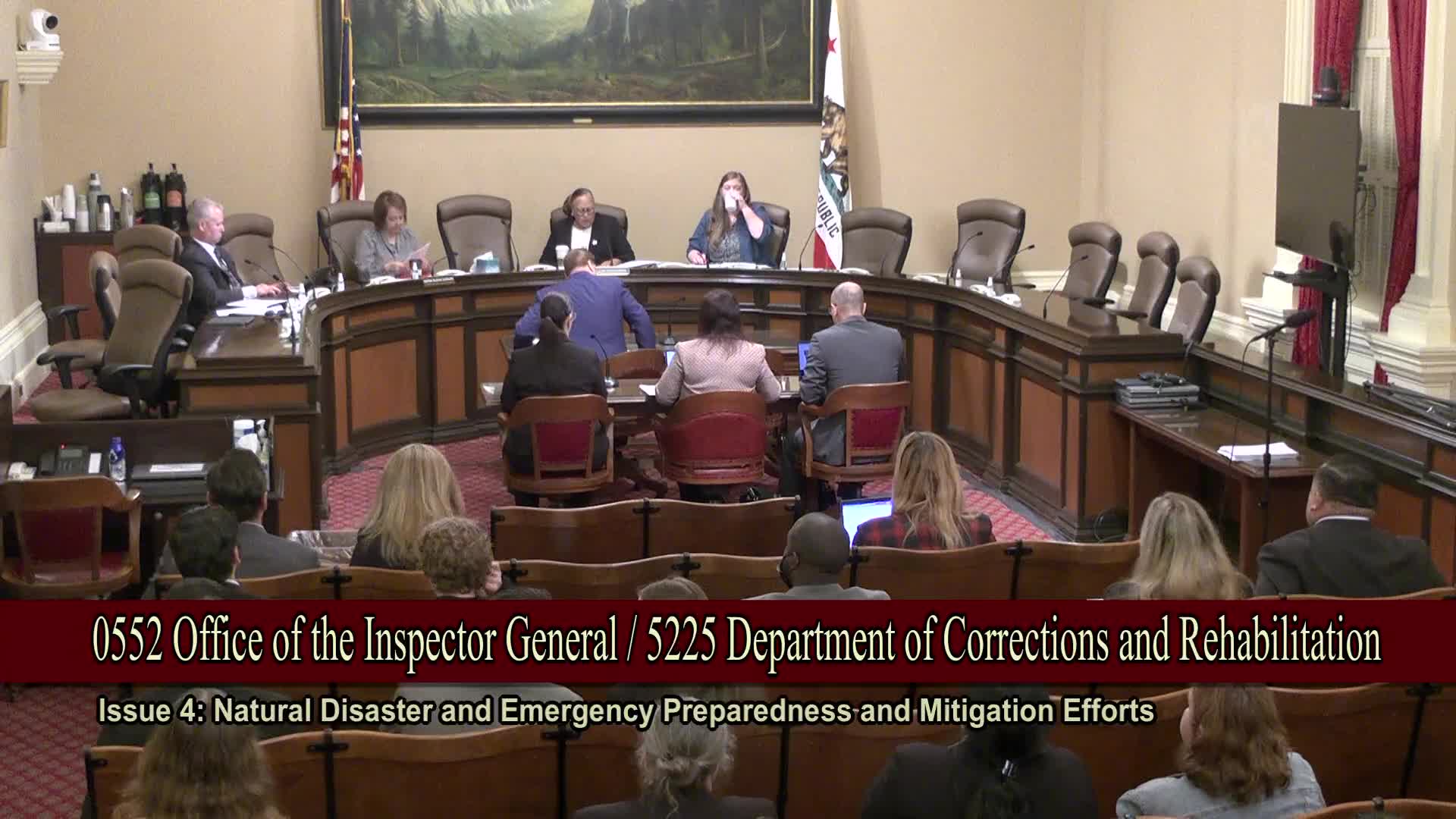Audit reveals California prisons lack adequate disaster evacuation plans
May 08, 2025 | California State Senate, Senate, Legislative, California
This article was created by AI summarizing key points discussed. AI makes mistakes, so for full details and context, please refer to the video of the full meeting. Please report any errors so we can fix them. Report an error »

The Senate Budget and Fiscal Review Subcommittee No. 5 convened on May 8, 2025, to discuss critical issues surrounding the California Department of Corrections and Rehabilitation (CDCR) and its preparedness for natural disasters. The meeting featured representatives from CDCR and the California Office of Emergency Services (Cal OES), who provided insights into the findings of a recent audit regarding the state's prison emergency response protocols.
The audit revealed significant vulnerabilities within California's prison system concerning wildfires, floods, and earthquakes. Key findings indicated that CDCR would struggle to evacuate incarcerated individuals and staff from most prisons within a 72-hour window during a natural disaster. While emergency operation plans exist, they were found to be overly general and inadequate for large-scale evacuations. Notably, none of the reviewed plans included detailed strategies for evacuating individuals outside prison gates.
The audit highlighted the limited availability of transportation resources, with CDCR operating a fleet of 30 buses and other vehicles spread across three regional hubs. The distance of these vehicles from various prisons raised concerns about their readiness in an emergency. For instance, the nearest bus to San Quentin State Prison is located approximately 90 miles away, while the closest vehicle to Pelican Bay State Prison is about 400 miles away. Additionally, the reliability of the fleet was questioned, as several buses had logged over 700,000 miles, exceeding the expected lifespan for such vehicles.
Overcrowding in California prisons, operating at 122% capacity as of December 2024, further complicates evacuation efforts. The audit noted inconsistencies in risk assessment methods among different prisons, with neighboring facilities reporting varying flood vulnerabilities. This inconsistency raises concerns about the adequacy of emergency plans and the potential for misjudgment during a disaster.
During the meeting, subcommittee members expressed their concerns regarding the adequacy of CDCR's emergency preparedness. Senator D'Araza emphasized the need for timely risk assessments and questioned the obstacles preventing CDCR from implementing effective evacuation plans. In response, CDCR representatives assured that they collaborate closely with Cal OES and have established emergency operations plans, but acknowledged the challenges posed by varying emergency scenarios.
The Inspector General pointed out that while CDCR has base plans in place, there is a pressing need for improvement in the accuracy and effectiveness of these plans, particularly in light of recent natural disasters. The subcommittee members urged CDCR to take the audit's recommendations seriously and to develop a comprehensive strategy for large-scale prison evacuations.
In conclusion, the meeting underscored the urgent need for CDCR to enhance its disaster preparedness protocols. The subcommittee plans to follow up on the implementation of the audit's recommendations to ensure the safety of both incarcerated individuals and staff during emergencies.
The audit revealed significant vulnerabilities within California's prison system concerning wildfires, floods, and earthquakes. Key findings indicated that CDCR would struggle to evacuate incarcerated individuals and staff from most prisons within a 72-hour window during a natural disaster. While emergency operation plans exist, they were found to be overly general and inadequate for large-scale evacuations. Notably, none of the reviewed plans included detailed strategies for evacuating individuals outside prison gates.
The audit highlighted the limited availability of transportation resources, with CDCR operating a fleet of 30 buses and other vehicles spread across three regional hubs. The distance of these vehicles from various prisons raised concerns about their readiness in an emergency. For instance, the nearest bus to San Quentin State Prison is located approximately 90 miles away, while the closest vehicle to Pelican Bay State Prison is about 400 miles away. Additionally, the reliability of the fleet was questioned, as several buses had logged over 700,000 miles, exceeding the expected lifespan for such vehicles.
Overcrowding in California prisons, operating at 122% capacity as of December 2024, further complicates evacuation efforts. The audit noted inconsistencies in risk assessment methods among different prisons, with neighboring facilities reporting varying flood vulnerabilities. This inconsistency raises concerns about the adequacy of emergency plans and the potential for misjudgment during a disaster.
During the meeting, subcommittee members expressed their concerns regarding the adequacy of CDCR's emergency preparedness. Senator D'Araza emphasized the need for timely risk assessments and questioned the obstacles preventing CDCR from implementing effective evacuation plans. In response, CDCR representatives assured that they collaborate closely with Cal OES and have established emergency operations plans, but acknowledged the challenges posed by varying emergency scenarios.
The Inspector General pointed out that while CDCR has base plans in place, there is a pressing need for improvement in the accuracy and effectiveness of these plans, particularly in light of recent natural disasters. The subcommittee members urged CDCR to take the audit's recommendations seriously and to develop a comprehensive strategy for large-scale prison evacuations.
In conclusion, the meeting underscored the urgent need for CDCR to enhance its disaster preparedness protocols. The subcommittee plans to follow up on the implementation of the audit's recommendations to ensure the safety of both incarcerated individuals and staff during emergencies.
View full meeting
This article is based on a recent meeting—watch the full video and explore the complete transcript for deeper insights into the discussion.
View full meeting
